The Role of Chemotaxis in Cell Physiology
Chemotaxis is described as the directed migration of cells towards a chemoattractant. This process is different from chemokinesis, which is undirected cell migration. When cells undergo chemokinesis, they alter their migrational properties (e.g., increase or decrease of migration speed) due to a substance, but do not migrate preferably in the direction of that substance.
Chemotaxis is induced by a specific substance, the chemoattractant. This substance can be a chemokine, a chemokine receptor, a growth factor, or a growth factor receptor. Important and well-described chemoattractants are, for example, the chemokine receptor CXCR4 and its ligand CXCL12, EGFR and EGF, and also CCR7 and CCL21.
The chemotactic network plays an important role in health and disease. On the one hand, chemotaxis is crucial in many physiological processes, such as during the recruitment of inflammatory cells or organ development. On the other hand, chemotactic processes can promote cancer progression, such as during the metastatic process, when malicious reprogramming of chemotaxis leads to cell invasion and dissemination.
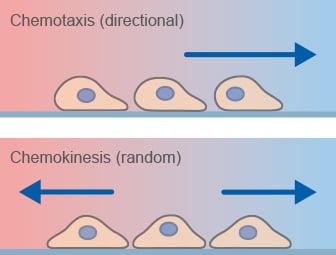
Chemotaxis-related migratory responses.
Tumor cells and their microenvironment constantly act in a complex communication network. Factors produced by epithelial tumor cells stimulate various immune cells, such as tumor-associated macrophages (TAMs), neutrophils, lymphocytes, and cancer-associated fibroblasts (CAFs). Upon stimulation, immune cells migrate towards the gradient, which can result in a tumor-suppressing or tumor-promoting immune answer.
Chemotaxis is also strongly involved in angiogenesis—an essential process that occurs during organ development and cancer progression. Angiogenesis helps to supply the tumor with oxygen and nutrients and is required for tumor dissemination. Tumor cells produce chemokines that influence the migration of endothelial cells, resulting in formation of the blood vessels. Further, chemokines can attract angiogenesis-promoting immune cells.
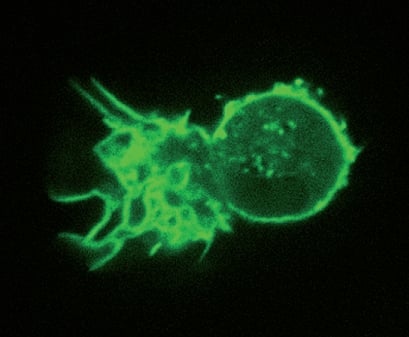
Murine dendritic cell with LifeAct-labeled F-actin that is migrating towards CCL19 inside a Collagen I gel matrix. Spinning disc confocal microscopy (objective lens 63x).
Types of Chemotaxis
Different cell types undergo different types of chemotaxis:
Multicellular (e.g., endothelial cells)
Collective Migration
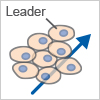 |
|
Cell Streaming
 |
|
Single Cells
Amoeboid Migration
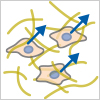 |
|
Mesenchymal Migration
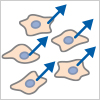 |
|
Trepat X, Chen Z, Jacobson K (2012) Cell migration. Compr Physiol 2(4):2369–92.
read abstract
Roussos ET, Condeelis JS, Patsialou A (2011) Chemotaxis in cancer. Nat Rev Cancer 11(8):573–587.
read abstract
Read on and learn more about different Chemotaxis Assays that exist, the Experimental Workflow of a Chemotaxis Assay, or how to do the Data Analysis of Chemotaxis Assays.




